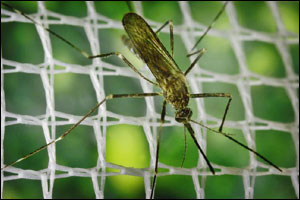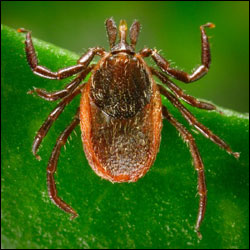CDC In the News
CDC's New Vector-Borne Infectious Disease Laboratory Opens in Fort Collins, Colorado
Published: May 30, 2007

This mosquito is suspected of being a vector of the Japanese Encephalitis virus in Asia, and the West Nile in the United States. (Photo by James Gathany)
After nearly three years of construction, CDC's new, state-of-the-art vector-borne infectious disease laboratory in Fort Collins is now both fully occupied and operational.
The $80 million facility, which is home to the Division of Vector-Borne Infectious Diseases, features a state-of-the-art laboratory supporting the mission of CDC as a national and international reference center for vector-borne viral and bacterial diseases; including West Nile virus, Lyme disease, Plague, Dengue Fever, Eastern Equine Encephalitis, and others.
CDC's vector-borne infectious diseases program has been based on the Foothills Campus of Colorado State University (CSU) in Fort Collins for 40 years (since 1967). The site was selected because of the unique collaborative opportunities for scientists at CDC and CSU and other partners located in northern Colorado.
The new laboratory provides much-needed space and state-of-the-art equipment for scientists as they continue to combat vector-borne infectious diseases that affect so many people around the world.

This photograph depicted a dorsal view of an adult female western blacklegged tick, Ixodes pacificus, which has been shown to transmit Borrelia burgdorferi, the agent of Lyme disease, and Anaplasma phagocytophilum, the agent of "human granulocytic anaplasmosis" (HGA), which was previously known as "human granulocytic ehrlichiosis" (HGE), in the western United States. (Photo by James Gathany)
The building consists of six floors: two laboratory floors with labs and related program offices, one vivarium floor, one insectary floor, one floor for logistics (glassware, shipping, storage), and one floor of mechanical space. In addition, interstitial mechanical floors are provided over the laboratory floors for ease of maintenance, worker safety, and minimization of program disruptions.
The new building features:
• Biosafety Level (BSL) 2 and 3 laboratories for the study of West Nile virus, Lyme disease, yellow fever, plague, dengue, and dengue hemorrhagic fever.
• More than 156,000 gross square feet of office and lab space for up to 55 scientists and support staff (the total gross area for the building is 159,607 square feet, plus 771 square feet for the Visitors Center. Project total = 160,378 square feet.)
• A replacement animal facility.
• An insectary for keeping, breeding, and studying live insects.
CDC's Division of Vector-Borne Infectious Diseases is one of the leading vector-borne research centers in the world. It holds a unique collection of Arboviruses, comprising more than 750 species and more than 1,200 strains, and serves as an international reference center for viral and bacterial diseases such as Lyme disease, plague and tularemia, and, of course, West Nile virus.
Content source: Centers for Disease Control and Prevention
